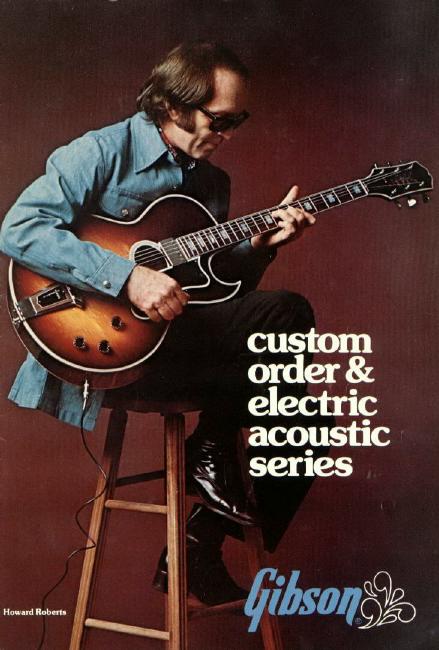
 |
This is the first professional level guitar owned by Howard Roberts. The following picture of this guitar is said to show Howard Roberts (at 19) and Pete Jolly (at 16) playing at a Local 586 Musicians Union party at the Mecca Lounge in Phoenix. The guitar was purchased by Al Flanagan of Phoenix just after H.R. sold it to a Phoenix music store in the late 40's. Since 2004 the guitar has been owned by his daughter Madelyn Roberts.
I bought that black Les Paul new that you mentioned in Equipment, from Tiny Timbrell ( good guitar player ) who worked at Fife and Nichols music store in Hollywood sometime in the fifties. I had a hard time playing it as the frets were too low and it felt stiff with heavy strings. I brought it back to Tiny after a few months and said I needed something else. Jim Hall was in the store at the time and we showed the guitar to him. He bought it and the rest is history.Ron also mentions that H.R. owned another ES-175 and that he cut a square hole in the back of it for some reason.
Very little is known about this guitar. He is shown playing it in a recently published book of photographs taken by the photographer Ray Avery during the late 1950's. Here is a summary of some comments by the L.A. session guitarist Mitch Holder, who first brought this to my attention, and a picture of one of these guitars.
The pictures on pages 147 and 148 of the book Stars of Jazz by Ray Avery, JazzMedia ApS, 1998 show the Gibson L-10. These are the only pictures I've ever seen of it and I knew nothing about it before. From looking at the evolution of the instruments he played, I think it's the forerunner of the Black Guitar (see below). When Howard got rid of the ES-175, he TRADED it to Jim Hall for Jim's black Les Paul Custom (there's a well known picture of Jim playing it in the Chico Hamilton Quintet in the '50's). The fingerboard on the L-10 pictured in the book (22 frets with block inlays but on a longer scale than a Les Paul, so would have to have been custom made) and the shape of the cutaway (L-10 was a non-cutaway originally, by the way) make it look almost like a Les Paul. I surmise that he had the custom stuff done and liked the smaller body of the 175 better than the 17" size of the modified L-10 and then went and found himself another candidate to modify (the ES-150 of Herb Ellis) and the rest is history, as they say. Like I said, I may be way off, but if you look at the evolution, it seems fairly logical. I haven't run across anyone here that remembers the L-10, so maybe he didn't play it for long. Another mystery, where is that modified L-10?
Wolf Marshall, a Los Angeles based guitarist and educator, is now the owner of this guitar. Wolf kindly supplied the following pictures of the front, back and body and some detailed information about the Black Guitar. Also visit Wolf's site (see Links). This has some lessons concerning Howard Roberts' playing style. Wolf also has an excellent article "Howard Roberts and the Black Guitar" in the August 2000 issue of Vintage Guitar Magazine.
It is indeed the first Gibson version of the Epi model. The Epi version wound up in the Gibson price list in '69 and early '70, as Gibsons. They only shipped 3 or 4, according to my shipping data. The main differences is the top (laminated maple vs solid spruce) and fingerboard (rosewood vs ebony) wood. The scale length is the same (25 1/2) with two more frets (22 vs 20). Interesting thing on this guitar is that the neck is three piece mahogany (production models and the Epi Custom were maple). I found that kind of interesting as Howard thought that the mahogany on the neck of the ES-175 he had was too soft and easy to bend. So, here's this prototype that he played all those years with a mahogany neck, although it being three piece makes it pretty hard to bend. It's cherry red (60's color). They had this color available for the first year and then they went to wine red. The pickguard shape gives this guitar away in the pictures, it's Gibson shaped rather than the Epi shape. Howard changed the pickguard, originally it did have the Epi shape. The guitar is triple bound on the back and all the production models had 7 piece binding (like the front). The strap pin was added (possibly for the times HR might have had to stand up at a clinic or something, but I sure never ever saw him use a strap). The Grover Roto's are original and the first year or two they did use the Grovers and then went to Schaller's with the screw to the inside instead of the bottom.Also Mitch points out that this guitar has only volume and tone controls while it originally had a third midrange tone control (see pictures of Gibson H.R. guitars below) but this has been plugged. Also the guitar has the word Custom written vertically on the truss rod cover which was not common with these guitars.
Interestingly this guitar is featured on the soundtrack to the movie Space Cowboys. The movie opens with a solo acoustic guitar piece called Espacio written by Clint Eastwood and beautifully played by Mitch. Mitch was told that this was going to be a session where a "Herb Ellis" guitar style was required and so he took this guitar along as the closest thing he had to an ES-175. Actually it turned out to be a session where an acoustic would have been appropriate but the H.R. Prototype really did the job. Here is a quote from Mitch describing the session.
We recorded the music at the tail end of a dialogue dubbing session with Donald Sutherland. Our calls are in 3 hour increments and I sat while Clint worked with Donald on his lines for a couple of hours. Then, with about 40 minutes left, Clint goes over to an upright piano and plays the tune for me. I wanted to write it out but Clint said I wouldn't need to, just listen a couple of times and do it (Clint likes to work FAST). Anyhow, they close miked the guitar and my main problem was remembering exactly how the first part of the melody went, had an odd length that was a little hard for me to catch and I was running it over when Clint told them to turn on the recorder. Seat of my pants, believe me. I still didn't really know the tune when I walked out of there and didn't remember most of it when I saw the movie last weekend. Was done REALLY fast!! Clint just told me to play it like I was a lonely guitar player out in the desert. I think the guitar actually turned out to have the perfect sound for it, a good flat top acoustic would have sounded more predictable, this had a little different flavor. All I did was change from the pick I use for jazz, a small heavy one, to a medium teardrop, (like a Fender Medium, made by D'Andrea) which I use on steel string acoustics and that brightened up the sound but, more importantly, put me in the right mind set to play that music on a jazz guitar. I'm really tickled that through the communication error, the HR guitar wound up on that movie, felt good to be getting it out there again. Think Howard was upstairs watching the whole thing go down and chuckling away. Thanx, Howard!!If you have heard the music then you will probably agree that this is quite an amazing description.
Here is a gallery of photos and some information about the guitars that I know Howard Roberts was involved in designing.
This is a photo of a guitar I own. The pickguard it came with was not original but I have replaced this with an original 1965 H.R. Epiphone Custom pickguard that I purchased from Phil's Guitars in San Francicso. Also it has been refretted but otherwise it is just as it was when made in 1968. I've replaced the tune-a-matic saddle with an ebony saddle made by Bruce Pritchard. This results in a warmer and richer tone. I believe this model is the finest of all the guitars that Howard Roberts was involved with.
I recently (September, 2010) purchased another Epiphone Howard Roberts Custom made in 1967 .
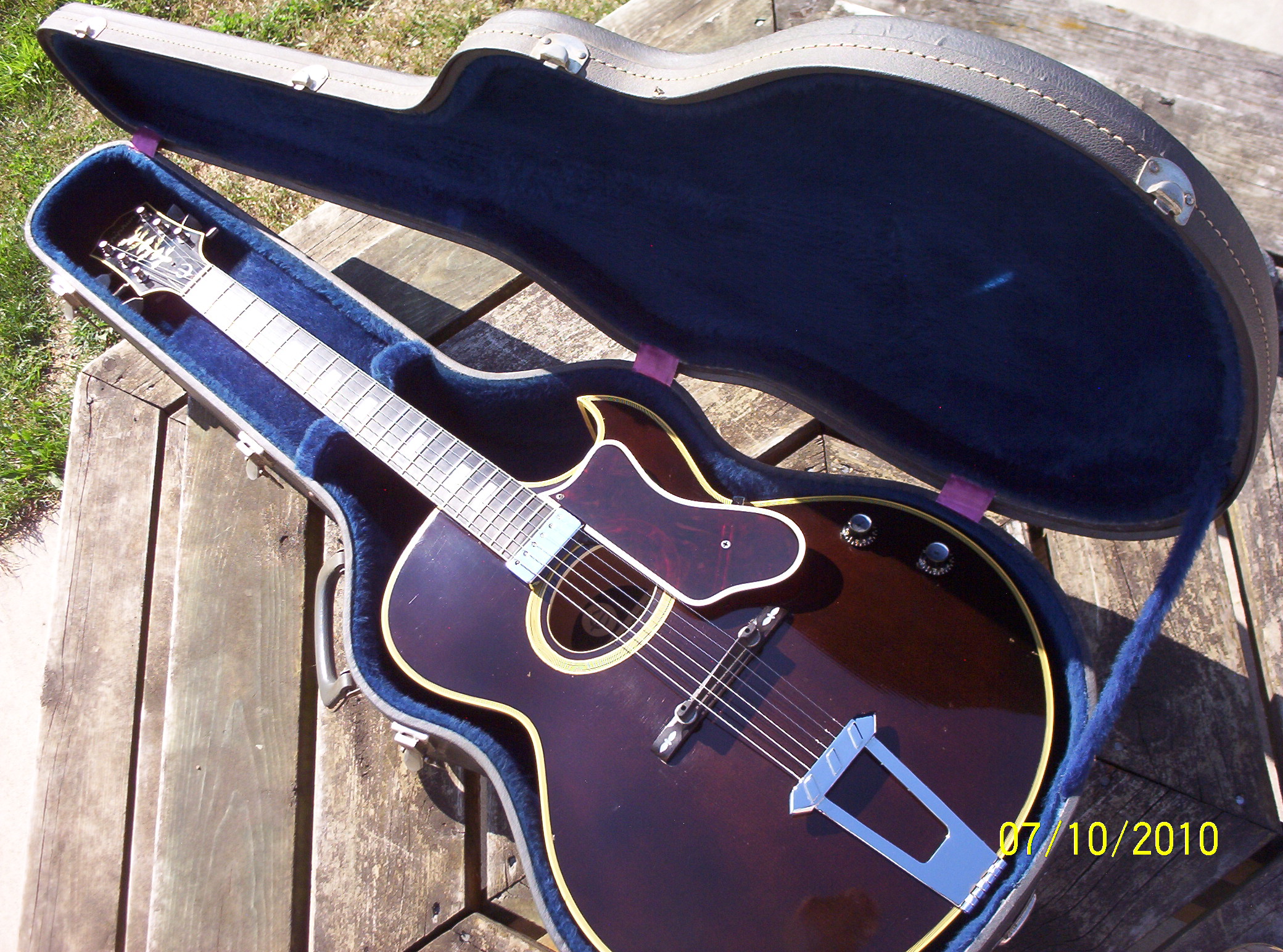
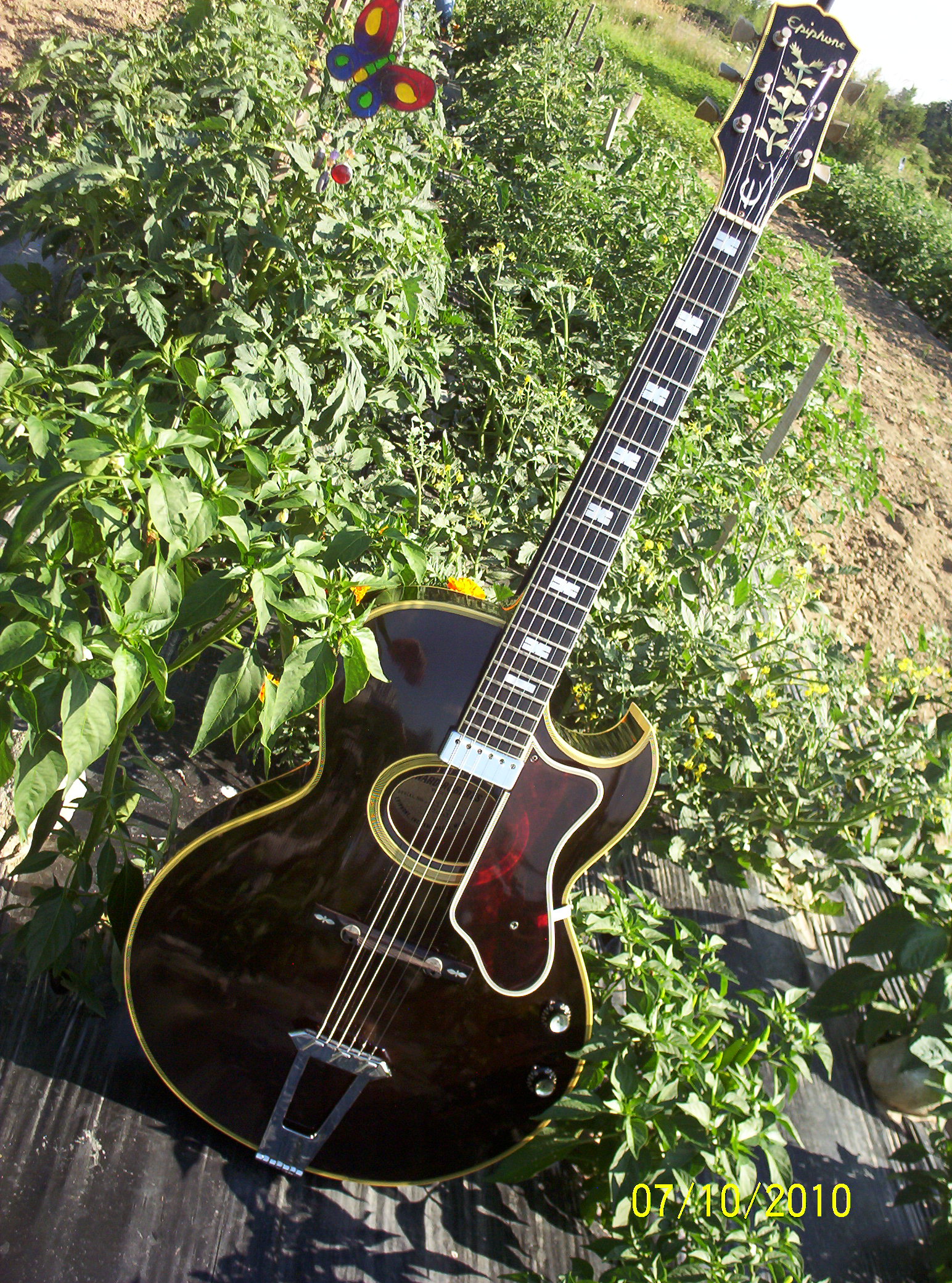
This guitar was previously owned by jazz guitarist Edward (Eudimio) Marocco of New Haven, Michigan and was sold to me by his guitarist son James 'Rocco' Marocco. This guitar was a special order and has some unique features especially with respect to the finish as several extra coats were added. The guitar is in beautiful condition and plays and sounds great.
I've read that this guitar was co-designed with Andy Nelson but it seems that this was not quite the case (see Andy Nelson's article about H.R. under Biography and Articles). Andy Nelson and Howard did design a guitar together but it was never produced as Gibson (which owned Epiphone - and still does) did not want to go to the expense of producing the tools to build an entirely new guitar. Instead the equipment which had been used to produce the Gibson L4 was available and after discussions between Ted McCarty (head of Gibson) and Howard the Howard Roberts Epiphone guitar was produced. The Standard (below) was introduced first in 1964 followed by the Custom in 1965. Both guitars were discontinued in 1970 when Epiphone moved its operations out of the U.S.A. From a copy of Andy Nelson's notes and sketch concerning this guitar, kindly made available by Jim Carlton, one can see that there are some differences between the original design and the final version of the guitar.
Mainly Electric - The Howard Roberts Guitar by Ken Achard and Craig Bradley, Guitar, Vol. 2, No. 5, 1973, Musical News Services, London is an article concerning the Epiphone Howard Roberts Custom. It notes that "an original is a rare find" and "Roberts had definite ideas on the sort of sound he wanted from his guitar. He liked the sounds from the humbucking pick-up, but wanted to retain the warmth and response from a carved round hole top, so much a feature of the early arch-top instruments". Also this instrument is profiled in The Epiphone Howard Roberts by George Gruhn and Walter Carter, Vintage Guitar, April 2006, p. 40.
The guitar has a solid carved spruce top with a Johnny Smith style floating pick-up and accordingly a beautiful tone both acoustically and amplified. It has a 7 piece neck which is the same as the neck on an old Epiphone Deluxe guitar. This model is a fairly rare guitar as only 52 (in walnut, black and natural) were ever made and in fact it took me some years of looking to find one. Mine is just like the guitar H.R. is pictured with on Goodies except that the pots on his were mounted on the pickguard. Actually I've been told that his guitar was stolen from him at some point and he had to acquire a new one. There is a nice picture of H.R. with this guitar (see below - courtesy of Barry Worrell) in Epiphone - The Complete History by Walter Carter, Hal Leonard, p. 67, 1995 but there is not much other information in that reference.
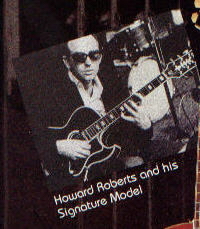
|
Many thanks to Mitch Holder and Jay Wolfe, both owners of this kind of guitar as well, for lots of the information quoted here.
Here is a list of players I know of who own one of these guitars.
Here is a picture of an H.R. Custom (owner unknown) with a Frequensator tailpiece. I got the following explanation from guitarist Garrison Fewell concerning the purpose of this device "Epiphone used them to change the tension on the strings. By making the bass strings longer through the tailpiece, the tension is higher and stiffer, making for a "tighter" bottom end sound, while the shorter top strings would have looser tension and therefore easier to play solos on the higher strings and upper frets of the instrument. I have a custom "frequensator" style tailpiece on my very modified 1947 Gibson L5.( It's a one-piece brass coated suspension and the stepwise graduation is much less severe than the stranger looking Frequensator which I have on my '65 Epihone Triumph). The L5 is slinkier to play with the shorter tailpiece - i.e. less tension on the strings, easer to play pulloffs and slurs more legato in the left-hand."
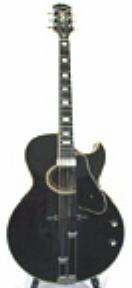
|
I'm interested in any further information about these guitars and in particular names of others who own them.
This is similar to the Epiphone Howard Roberts Custom discussed above but lacking the finer finishing of that guitar. Also the Standard had 24.75" scale length while the Custom had a 25.5" scale length. There were 290 of these guitars made in sunburst and natural.
Pat Farrand makes Dampers for guitars and these were recently featured in an issue of Just Jazz Guitar. You can see one of his Headstock Dampers installed on his guitar in the photo. I purchased one of these and I can attest to the quality of his workmanship. These allow you to play an archtop without those sometimes annoying overtones from unmuted strings and help to remove feedback problems when you are playing at higher volumes. Pat can be contacted at:
Mr. Pat Farrand
Here is a list of players that I know play this guitar.
I used to own one of these guitars I liked it a lot. It didn't have the same quality of tone as the Epiphone Custom, as it has a laminated top, but I liked the neck on it as it plays very easily. Also Gibson made the Howard Roberts Custom (many thanks to Barry Worrell for the picture and also this one). The Artist simply had finer finishing and in particular gold plating. Obviously the design of this guitar was based on the Epiphone version with some changes; e.g. different pick-up, laminated top, and overall a much heavier guitar. It was introduced in 1974 and mine is from 1977. There was a two pick-up version made in 1979-80 (thanks to John Kally for this information).
According to Howard Roberts the guitar is much like an ES-175 but stronger and of course with an oval sound-hole and floating pick-up. Here is a schematic of the wiring.
I also used to own a Gibson ES-175 made in 1959 and I prefer the Artist to that. The Artist has a better tone electrically and is somewhat better acoustically although both have a poor acoustic tone. Just my opinions of course!
Mitch Holder is the proud owner of the prototype H.R. Gibson that Howard Roberts used on many recording sessions. H.R. is pictured dining with this guitar on the front of Equinox Express Elevator! Here is a picture of a beautiful cherry H.R. Custom owned by Rowland Harris of Greenville, N.C.
Another cherry Gibson (with an odd tailpiece) can be seen here.
I don't know much about this guitar, pictured here being played by well-known guitarist John Pisano, but a few details (and the picture) have been made available by Alan Waite who was involved with H.R. in trying to market this at one point in time. It seems this guitar was part of H.R.'s Chroma method for guitar instruction (note the multicolored strings). According to Alan "The colored strings relate to a chart he had. The music notes were in color, so you played the color of the strings that matched the notes." Many thanks to Alan for this information.
This guitar seems to be another version of the Gibson Howard Roberts. These guitars were made in the period 1976-79 and were direct copies of the Gibson version. Ibanez (a Japanese company) seemed to do this with a number of guitars during this period; i.e. just copy another company's instrument. How were they able to get away with doing this? There are some details concerning this situation and how it changed in the book Guitar Stories - Volume 1 by Michael Wright, 1999.
I've seen other versions of this guitar with yet other manufacturer names on them; e.g. Electra, Halifax ( headstock), Hoyer ( thanks to Steven Husting who also adds that "The guitar is made of solid maple and spruce with a mahogany/rosewood neck."), Mann, Penco, Speedfire (thanks to Phil Proctor of Mobile, Alabama), Starfield and Ventura. From Jon Dalton I've learned that two versions of this guitar were sold in the United Kingdom under the Ibanez and Antoria (look here for a beautiful example of one of these owned by Jon) labels. Thanks to Tom Prescott's research I've learned that all of these guitars (Ibanez, Greco, Electra) were made by a Japanese company called Hoshino Gakki Ltd. At one point there was a lawsuit initiated by Gibson against the company. Around this time Ibanez ceased copying other guitars and started producing its own models. Steve Thurgood has informed me that he once owned a guitar made by this company with the name KopyKat written on the headstock and the word Howie on the tailpiece!
This guitar is identical to the Ibanez model but seems to have been a version directed at the Japanese market rather than for export.
I encountered this picture on the internet. The accompanying text indicated that this guitar was made by the Swedish guitar company Goya (see headstock) which I believe has an affiliation with Hagstrom. I'm a litte skeptical of this and tend to think it is probably just another of the Ibanez "lawsuit" copies. If anybody can supply more details please let me know.
This guitar is owned by William Kelly. It seems that this guitar was made by Matsumoko. Later, cheaper versions of this guitar were made by Fuji Gen Gakki. It does seem to be a finer version of the so-called "lawsuit" models.
I don't know much about this guitar although it looks almost identical to the Gibson model. I believe H.R. had a endorsement deal with Aria for a short period. Aria (founded in Japan by a Mr. Arai) is a distinct comapny from Ibanez.
This guitar was designed to be able to handle both rock (i.e. loud volumes) and jazz contexts. It seems that Ibanez also copied this guitar selling it under the name Hondo Howard Roberts at one point. Here is a picture of what appears to be an early prototype of this guitar as sold by Gibson. Interestingly it is a full bodied ES-175 style of guitar rather than the ES-335 style of guitar that it ultimately became. Notice also the stop tail-piece on this guitar. This was also a feature on the early thinline models but was changed to the fingers tail-piece sometime in the 90's (I've been told that this cuts down on harmonics from the strings vibrating behind the bridge).
I own one of these instruments and indeed it is a very versatile guitar. You can get a great jazz, rock or country sound from it and play at high volumes with **no** feedback. Here is a description of the guitar from Gibson.
Howard Roberts FusionAs a musician and as a guitar designer Howard Roberts brought the jazz guitar to a new level. The Howard Roberts Fusion model debuted in 1980 with such refinements as a more open cutaway, a unique control configuration, and the "fingers" tailpiece with the ability to adjust the downward string pressure over the bridge. This gives the player the ability to create a custom action/feel. Model Howard Roberts Fusion
Pickups: Rhythm - 49OR alnico magnet humbucker, Treble - 49OT alnico magnet humbucker
Hardware: Gold
Scale Length: 24-3/4"
Fingerboard/Inlay: Ebony, 22 frets/Dot
Binding: MuIti.ply top; single.ply fingerboard and back
Bridge/Tailpiece: Tune-o.matic/Finger
Material Notes: Laminated maple; Chromytew center block
Finish: Cherry, Ebony, Vintage Sunburst
Video Tribute to the Howard Roberts Fusion Guitar
Dan Kaminsky has created the following tribute to this guitar.
Eli Mondragon provided the following information about Epiphone versions of this guitar. He writes "Here are pictures of the VERY rare Epi HR Fusion guitars that were made about 1986 /88....Top one is the Fusion II with 2 Humbuckers and bottom is Fusion III with 2 Single Coils and a Humbucker.. " and has put pictures up on Youtube.
https://www.youtube.com/watch?v=rjkdBC_QALI
This is a picture of a guitar owned by the guitarist and photographer Rowland Harris of Greenville, North Carolina. Rowland has kindly supplied us with another view of the front and the back. Also, a picture of Alan Joseph, of the University of Denver, playing one of these guitars can be found here. This guitar is another version of the Epiphone and Gibson guitars, at least in appearance, and was available from Epiphone during the 90's. The sound hole appears to be much bigger. It is quite a nice guitar.
There also appears to have been an earlier version of this guitar manufactured in Japan rather than Korea. Here is a picture of one of these owned by Jerry Carden. Note the smaller soundhole. It seems much close to the original model.
I believe this (front, back open is the kind of amplifier that Howard Roberts played during the the 1950's. This was a tube amp with two (8 and 12 inch) Jensen speakers.
Howard Roberts helped design the Benson line of amplifiers and of course played one of these. He was also a cofounder, with Ron Benson, of the company Benson Electronics. Ron told me that in part the aim of the design of the Benson amps was to capture the sound H.R. got from the GA50. I spoke with Ron and have a short history of the company at the following link.
In my opinion Howard Roberts had one of the nicest tones of any electric guitarist that I have heard and perhaps this is, in part, because he helped to design his guitars and amps to meet his personal tastes.
There were several models of the Benson amplifier: the 300, 400 and the head/cabinet combinations the 330 and 360. The 300 was 50 watts and had a 15" speaker and the 400 was 100 watts with four 12" speakers. Howard played a 300 but it had a separate head and speaker. When he travelled he took only the head with him finding speakers to use at each location where he played.
Doug Miers has a 200 model Benson amplifier that he obtained from L.A. studio guitarist Al Casey. It has a single 12" speaker and about 40 watts with two EL34 tubes, reverb and tremolo. All of this in a case only 14" inches tall, 19" across, and about 7" deep. Here is a picture of Doug's amp. Al Casey was on most of Duane Eddy's albums, everything that Lee Hazelwood did, everything by Nancy Sinatra, and recorded with the Monkees, the Association, the Beach Boys, and on and on. He also studied with Howard Roberts. Thanks to Doug for this information. Here is another picture, again courtesy of Doug, of two Benson amplifiers. The big one is a 300 described below. B. Kendall Berg is also the owner of a Benson 200, previously owned by studio drummer Joe Porcaro.
I purchased a Benson 300 amp. I can confirm that it has a very nice jazz tone. In fact it compares favourably with an Evans E200 that I also own. If anything the Benson is a little warmer perhaps because it is a tube amp. Here are the schematics for this amp (many thanks Allen Kelinsky): schematic 1, schematic 2. Here is a copy of the manual.
There were a set of "modules" that could be attached to the back of the amp to modify the tone. I'm not sure exactly how these worked but here are some comments by Ron Benson on these (many thanks to B. Kendall Berg).
There is an article in a recent issue of Just Jazz Guitar which features considerable discussion about the Benson 300 amplifier. High praise is given for this amp. The article in question is Controlling Feedback, by Darwin Evans, Just Jazz Guitar, No. 18, February, 1999, p. 90-91.
There is also the article Studio Sweet - The benson Model 200 by Dave Hunter, Vintage Guitar magazine Nov. 2019, p. 48, which provides some useful information.
Howard Roberts used very heavy strings on his guitars, even by the standards of most jazz guitarists. Considering that bends were an important part of his technique this is quite amazing. Mitch Holder, currently a professional guitarist in Los Angeles and who studied with Howard Roberts, supplied the following gauges from his records: .016, .018, .028, .038, .048, .058. Further details from Mitch indicate that these were Gibson Mona Steel, Set No. 240 and he had to get heavier gauge B & E strings (brand really doesn't matter on the unwound strings, all steel) to get the tension he was after.
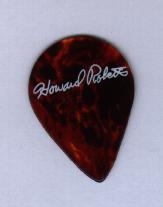 Thanks to Patty Roberts I recently acquired some guitar picks from Howard
Roberts' personal collection. Here is a picture of the
back of the pick. It is a heavy
pick, at least heavier than I was used to using.
The gauge is 1mm and it gives a nice tone. The type of plastic seems to have something
to do with this as well.
Thanks to Patty Roberts I recently acquired some guitar picks from Howard
Roberts' personal collection. Here is a picture of the
back of the pick. It is a heavy
pick, at least heavier than I was used to using.
The gauge is 1mm and it gives a nice tone. The type of plastic seems to have something
to do with this as well.